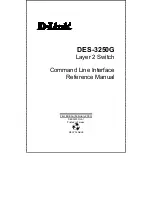
D-Link DES-3326SR Layer 3 Switch
Figure B- 2. The Protocol Stack
Between two protocol stacks, members of the same layer are known as peers and communicate by well-known (open and
published) protocols. Within a protocol stack, adjacent
layers communicate by an internal interface. This interface is usually not publicly documented and is frequently proprietary.
It has some of the same characteristics of a protocol and two stacks from the same software vendor may communicate in the
same way. Two stacks from different software vendors (or different products from the same vendor) may communicate in
completely different ways. As long as peers can communicate and interoperate, this has no impact on the functioning of the
network.
The communication between layers within a given protocol stack can be both different from a second stack and proprietary,
but communication between peers on the same OSI layer is open and consistent.
A brief description of the most commonly used functional layers is helpful to understand the scope of how protocol layering
works.
Layer 1
This is referred to as the physical layer. It handles the electrical connections and signaling required to make a physical link
from one point in the network to another. It is on this layer that the unique Media Access Control (MAC) address is defined.
Layer 2
This layer, commonly called the Switching layer, allows end station addressing and the establishment of connections
between them.
Layer 2 Switching forwards packets based on the unique MAC address of each end station and offers high-performance,
dedicated-bandwidth of Fast or Gigibit Ethernet within the network.
Layer 2 does not ordinarily extend beyond the intranet. To connect to the Internet usually requires a router and a modem or
other device to connect to an Internet Service Provider’s WAN. These are Layer 3 functions.
Layer 3
Commonly referred to as the routing layer, this layer provides logical partitioning of networks (subnetting), scalability,
security, and Quality of Service (QoS).
The backbone of the Internet is built using Layer 3 functions. IP is the premier Layer 3 protocol.
IP is itself, only one protocol in the IP protocol suite. More extensive capabilities are found in the other protocols of the IP
suite. For example; the Domain Name System (DNS) associates IP addresses with text names, the Dynamic Host
Configuration Protocol (DCHP) eases the administration of IP addresses, and routing protocols such as the Routing
Information Protocol (RIP), the Open Shortest Path First (OSPF), and the Border Gateway Protocol (BGP) enable Layer 3
devices to direct data traffic to the intended destination. IP security allows for authentication and encryption. IP not only
allows for user-to-user communication, but also for transmission from point-to-multipoint (known as IP multicasting).
193
Содержание DES-3326SR
Страница 240: ......
















































